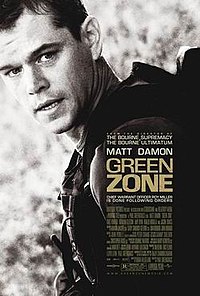Re-posted from March 29th, 2010
I’m on vacation right now with my wife sans kids for a couple days and one of the things we got to do today was hit a movie which is a rarity in our life stage. We were on a time table and decided to watch The Green Zone.
I didn’t know anything about his movie when I went in – guy at the theater said it was like a Jason Bourne movie. That sounded good to me at the time. To be clear, it’s not a Bourne movie and it had more similarities to Black Hawk Down than the Bourne films though it was less war movie than political thriller.
 There’s a lot of political controversy about this movie and I’m not making a lot of statements about what some have called an “anti-American” bias. Politics aside – while there might be some sensationalism, most of the themes and portrayals are extremely believable and did not come off to me like propaganda. So politics aside, the movie was all about leadership and I left with the wheels turning. I had to get some of my thoughts and reactions down before they go away.
There’s a lot of political controversy about this movie and I’m not making a lot of statements about what some have called an “anti-American” bias. Politics aside – while there might be some sensationalism, most of the themes and portrayals are extremely believable and did not come off to me like propaganda. So politics aside, the movie was all about leadership and I left with the wheels turning. I had to get some of my thoughts and reactions down before they go away.
I posted a couple brief explanations from wikipedia below as to what the “Green Zone” is, but without providing a spoiler for the movie – the Green Zone is essentially a safe bubble in the midst of the leadership arena. There is a scene where the unit led by Damon’s character is fresh off of a mission in dangerous sections of Baghdad, Iraq and then he is summoned back to a meeting in the Green Zone with an official. He and his unit stumble upon a pool in which there are tons of people partying poolside with pizza and bear and girls in bikini’s. One of the soldiers says something to effect of “What the…?” They are startled by how disconnected the higher levels of leadership are from their reality on the ground.
The Green Zone is where leaders are cutting deals and gathering information from a distance, but they are immune to the real sufferings and plights of the people and the community. Values and beliefs from one context are being imported into a different context with an imperialistic vibe and no learning posture.
Leadership at any level can start to reflect the “Green Zone” when the servant posture erodes into a comfort posture. However, one of the important things is that many of leaders in the green zone believed they were doing great things and on a moral quest of sorts. That doesn’t equate to servant leadership though and can often lead to just the opposite.The “Green Zone” in the movie and in my experience is when leaders make big decisions with bad information or no information (bad or no intel). Leaders are leading from the “Green Zone” when leaders from one culture and ethnic group keep making decisions for other ethnic groups assuming that what goes for one goes for all. Leaders are leading from the “Green Zone” when they choose to live large and comfortable, immunizing themselves against the real stories of those they lead or in their communities or in the world.
Are you leading from the “Green Zone?” Matt Damon’s character plays the prophetic, change agent role and it’s an inspiring picture of servant leadership. Again, some of you might react to the political spin of the movie, but it’s not overt propaganda. The leadership issues in this movie are all to real and common and it’s a great theatrical illustration of “Green Zone” leadership versus Servant Leadership.
From Wikipedia:The Green Zone is the common name for the International Zone of Iraq—a 10-square-kilometer (3.8-square-mile) area in central Baghdad, Iraq, that was the center of the Coalition Provisional Authority and remains the center of the international presence in the city. Its official name beginning under the Iraqi Interim Government is the International Zone, though Green Zone remains the most commonly used term.The Green Zone is completely surrounded by high concrete blast walls, T-Walls and barbed wire and access was available through a handful of entry control points, all of which were controlled by Coalition troops.[7] It is this security that makes the Green Zone the safest area of Baghdad,[7] and is referred to colloquially as “the bubble”.[8]
REPOSTED from March 29th, 2010
